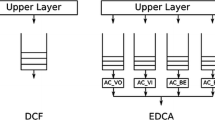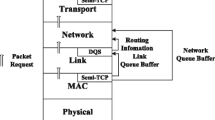Abstract
Next generation Wireless Local Area Networks (WLAN’s) are likely to require multihop wireless connections between mobile nodes and Internet gateways to achieve high data rates from larger distances. The paper addresses the challenges in concurrently providing a wide range of end-to-end throughput and delay assurances in such mobile multihop WLAN hotspots. The proposed solution is based on the Neighborhood Proportional Delay Differentiation (NPDD) service model. With NPDD, Transmission Control Protocol (TCP) based applications achieve their desired throughputs using a dynamic class selection mechanism. This approach integrates well with the NPDD-based end-to-end delay assurance mechanism proposed earlier. To better model the node mobility in a multihop hotspot in our simulation studies, the Public Hotspot Mobility (PHM) model is proposed. Simulation results show that the proposed solution is better in meeting the desired throughputs and delays as compared with best effort and strict priority approaches. Recent theoretical analyses show that the NPDD model with a continuous range of classes can guarantee convergence to desirable QoS through dynamic class selection. However, the overhead of realizing the continuous class scheduler is high. We propose two continuous NPDD schedulers, the Single Queue Continuous NPDD (SQ-CNPDD) scheduler and the Multiple Queue Continuous NPDD (MQ-CNPDD) scheduler, to realize the continuous NPDD model. With simulations, the performance of SQ-CNPDD and MQ-CNPDD are compared to that of NPDD.
Similar content being viewed by others
References
S. Bansal, R. Gupta, R. Shorey, I. Ali, A. Razdan and A. Misra, Energy efficiency and throughput for TCP traffic in multi-hop wireless networks, in: Proceedings of IEEE INFOCOM (2002) vol. 1, pp. 210–219.
S. Choi, J. del Prado, N. Saishankar and S. Mangold, IEEE 802.11e contention-based channel access (EDCF) performance evaluation, in: Proceedings of IEEE International Conference on Communications (2003) vol. 2, pp. 1151–1156.
C. Dovrolis, D. Stiliadis and P. Ramanathan, Proportional differentiated services: Delay differentiation and packet scheduling, IEEE/ACM Transactions on Networking 10(1) (2002) 12–26.
M. Gerla, K. Tang and R. Bagrodia, TCP performance in wireless multi-hop networks, in: Proceedings of IEEE Workshop on Mobile Computing Systems and Applications (1999) pp. 41–50.
R.A. Guerin, Channel occupancy time distribution in a cellular radio system, IEEE Transactions on Vehicular Technology 36 (1987).
J. Heinanen, F. Baker, W. Weiss and J. Wroclawski, Assured Forwarding PHB Group, IETF RFC 2597 (June 1999).
G. Holland and N. Vaidya, Analysis of TCP performance over mobile ad hoc networks, in: Proceedings of ACM MOBICOM (1999) pp. 219–230.
IEEE Std. 802.11, Wireless LAN media access control (MAC) and physical layer (PHY) specifications (1999).
IEEE Std. 802.11a, Wireless LAN media access control (MAC) and physical layer (PHY) specifications: High-speed physical layer in the 5 GHz band (1999).
IEEE Std. 802.11b, Wireless LAN media access control (MAC) and physical layer (PHY) specifications: Higher-speed physical layer extension in the 2.4 GHz band (1999).
V. Jacobsen, K. Nichols and K. Poduri, An expedited forwarding PHB (per-hop behavior), IETF RFC 2598 (June 1999).
D.B. Johnson and D.A. Maltz, Dynamic source routing in ad hoc wireless networks, Mobile Computing (1996) 153–181.
D.B. Johnson, D.A. Maltz and J. Broch, The dynamic source routing protocol for multihop wireless ad hoc networks, Ad Hoc Networking (2001) 139–172.
S.-B. Lee, G.-S. Ahn and A.T. Campbell, Improving UDP and TCP performance in mobile ad hoc networks with INSIGNIA, IEEE Communications Magazine (June 2001) 156–165.
H. Luo, S. Lu and V. Bharghavan, A new model for packet scheduling in multihop wireless networks, in: Proceedings of ACM MOBICOM (Aug. 2000) pp. 76–86.
J.G. Markoulidakis, G.L. Lyberopoulos, D.F. Tsirkas and E.D. Sykas, Mobility modeling in third-generation mobile telecommunications systems, IEEE Personal Communications Magazine 4(4) (1997) 41–56.
K. Nichols and B. Carpenter, Definition of differentiated services per domain behaviors and rules for their specification, IETF RFC 3086 (April 2001).
J. Padhye, V. Firoiu and J. Kurose, Modeling TCP throughput: A simple model and its empirical validation, in: Proceedings of ACM SIGCOMM (1998) vol. 28, pp. 303–314.
The VINT Project, The Network Simulator - ns-2 v.2.1b7a, (Nov. 2000) http://www.isi.edu/nsnam/ns/.
K.-C. Wang, Quality of service assurances in multihop wireless networks, Ph.D. thesis, University of Wisconsin, Madison (2003).
K.-C. Wang and P. Ramanathan, End-to-end delay assurances in multihop wireless local area networks, in: Proceedings of IEEE GLOBECOM (2003).
K.-C. Wang and P. Ramanathan, End-to-end throughput and delay assurances in multihop wireless hotspots, in: Proceedings of ACM International Workshop on Wireless Mobile Applications and Services on WLAN Hotspots (2003) pp. 93–102.
K.-C. Wang and P. Ramanathan, QoS assurances through class selection and proportional differentiation in wireless networks, Submitted to IEEE Journal on Selected Areas in Communications Special Issue on Wireless Ad Hoc Networks (2004).
P.P. White, RSVP and integrated services in the Internet: A tutorial, IEEE Communications Magazine 35(5) (1997) 100–106.
S. Xu and T. Saadawi, Does the IEEE 802.11 MAC protocol work well in multihop wireless ad hoc network, IEEE Communications Magazine 39(6) (2001) 130–137.
Author information
Authors and Affiliations
Corresponding author
Additional information
Kuang-Ching Wang received the B. S. and M. S. degrees in electrical engineering from the National Taiwan University, Taipei, Taiwan, in 1997 and 1999, and the M. S. and Ph. D. degrees in electrical and computer engineering from the University of Wisconsin, Madison, in 2001 and 2003, respectively. Dr. Wang is currently with the Department of Electrical and Computer Engineering, Clemson University, Clemson, SC, as an Assistant Professor. From 2000 to 2003, he participated in the DARPA Sensor Information Technology (SensIT) Program as the leading developer of its network protocols and collaborative signal processing applications. His research interests include wireless networks, mobile computing, distributed protocols, and embedded systems. Dr. Wang is a member of the IEEE Computer, Communication, and Biomedical Engineering Societies and the Association for Computing Machinery.
Parameswaran Ramanathan received the B. Tech degree from the Indian Institute of Technology, Bombay, India, in 1984, and the M. S. E. and Ph. D. degrees from the University of Michigan, Ann Arbor, in 1986 and 1989, respectively. Since 1989, Dr. Ramanathan has been faculty member in the Department of Electrical & Computer Engineering, University of Wisconsin, Madison, where is presently a Full Professor. He leads research projects in the areas of sensor networks and next generation cellular technology. In 1997–98, he took a sabbatical leave to visit research groups at AT&T Laboratories and Telcordia Technologies. Dr. Ramanathan’s research interests include wireless and wireline networking, real-time systems, fault-tolerant computing, and distributed systems. He is presently an Associate Editor for IEEE Transactions on Mobile Computing and Elsevier AdHoc Networks Journal. He served as an Associate Editor for IEEE Transactions on Parallel and Distributed Computing from 1996–1999. He has also served on program committees of conferences such as Mobicom, Mobihoc, International Conferences on Distributed Systems and Networks, Distributed Computing Systems, Fault-tolerant Computing Symposium, Real-time Systems Symposium, Conference on Local Computer Networks, and International Conference on Engineering Complex Computer Systems. He was the Finance and Registration Chair for the Fault-tolerant Computing Symposium (1999). He was the program co-chairman of the Workshop on Sensor Networks and Applications (2003), Broadband Wireless (2004), Workshop on Architectures for Real-time Applications, 1994 and the program vice-chair for the International Workshop on Parallel and Distributed Real-time Systems, 1996. He is a member of Association of Computing Machinery and a senior member of IEEE.
Rights and permissions
About this article
Cite this article
Wang, KC., Ramanathan, P. A Cross-Layer Approach for Concurrent Delay and Throughput Assurances in Multihop Wireless Hotspots. Mobile Netw Appl 10, 341–353 (2005). https://doi.org/10.1007/s11036-005-6427-z
Issue Date:
DOI: https://doi.org/10.1007/s11036-005-6427-z




